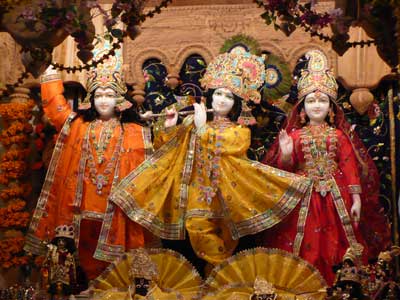

During the auspicious Kartika month this year, Srila Bhaktivedanta Narayana Gosvami Maharaja has been giving his morning and evening classes in Gopinatha Bhavan, a brand-new temple/housing complex made of red sandstone. Gopinatha Bhavan is situated on the banks of the Yamuna, right next to the holy Imlitala, which is considered by pure Gaudiya Vaisnavas to be one of the most sacred of all holy places of Sri Krsna’s pastimes. Imlitala is the very place where Krsna came when Srimati Radhika had disappeared during the rasa dance. Here, Krsna wept bitterly in separation from Radhika and, fully absorbed in thoughts of Her, assumed Her golden complexion.
On the first day of Kartika, Srila Narayana Gosvami Maharaja installed the Deities Sri Sri Radha-Gopinatha and Sri Caitanya Mahaprabhu in the main hall of Gopinath Bhavan. As the first day of Kartika was also the divine disappearance day of his most worshipable Gurudeva, Srila Bhakti Prajnana Kesava Gosvami Maharaja, Srila Narayana Maharaja led the 1,000 international pilgrims present in observing that auspicious separation festival.
The day began with mangala-arati at 5am, then singing of bhajans, and then Srila Maharja’s morning class. As he is accustomed to doing every year, he began speaking on the sweet infanthood pastimes of Lord Sri Krsna from Sri Damodarastakam, spoken by Satyavrata Muni in Padma Purana, with commentaries by Sri Sanatana Gosvami and Srila Bhakti Prajnana Kesava Gosvami.
After the class, he and the devotees proceeded to the Yamuna where he guided the devotees in taking sankalpa (vows) for the entire parikrama month. As Sripad Tirtha Maharaja chanted the sankalpas, the devotees took acamana from Yamuna, offered flowers to her, and prayed to her for the fulfillment of their spiritual aspirations.
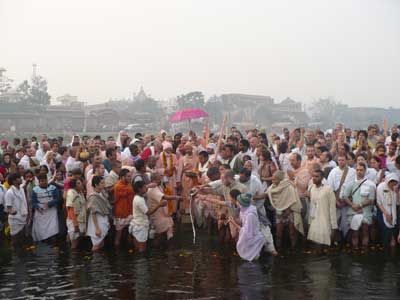
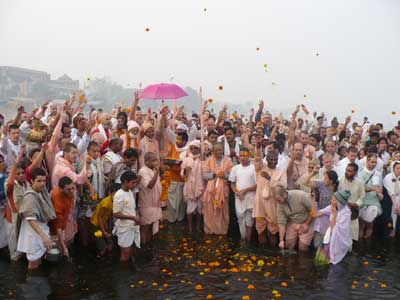
The installation ceremony began shortly after the sankalpa. The devotees assembled in the hall of Gopinath Bhavan and the Deities were brought before the altar. As everyone chanted ecstatically, the Deities and Natha Mandira were prepared for installation. Brahmanas chanted auspicious mantras to remove all inauspicious elements, and to invite the deities of the ten directions to be present.
Sripad Tirtha Maharaja conducted the grand fire sacrifice and Srila Maharaja came to perform the actual installation. Assisted by other devotees, Srila Maharaja bathed the Deities with yoghurt, milk, sugar, honey, rose-water, cow-dung and cow-urine.
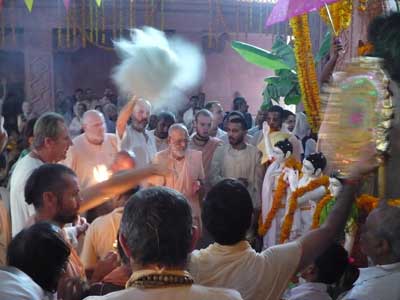
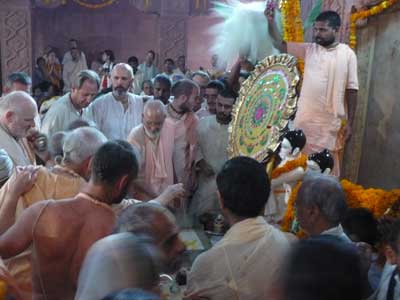

While the fire sacrifice was performed, Srila Maharaja sat on the vyasasana and gave a speech, offering the flowers of his heartfelt feelings, and glorifying his Guru Maharaja’s character and philosophy. He also requested devotees and guests to speak.
During the speeches and beautiful kirtanas, the Deities were brought to the altar and dressed gorgeously. Then, Srila Maharaja went to the altar and performed the final details of the installation process. Then, after the 12pm bhoga offering of delicious preparations, the curtains were opened and the devotees could delight for the first time in the full exquisite beauty of Sri Sri Radha-Gopinatha and Sriman Mahaprabhu. The noon arati was followed by a sumptuous feast.
Later, in the evening, everyone assembled again, to hear Srila Maharaja speak further about the glories of his Gurudeva, parama-pujyapada Sri Srimad Bhakti Prajnana Kesava Gosvami Maharaja. The following is an excerpt from his speech:
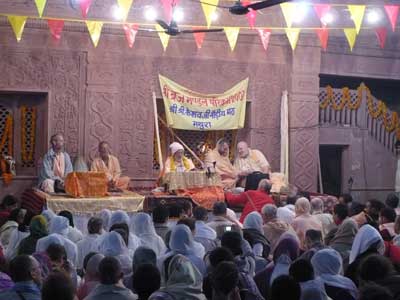
“My Guru Maharaja had the highest class of staunch faith in his Gurudeva (guru-nistha), and he was a rupanuga Vaisnava.
“What is rupanuga? Rupanuga does not necessarily refer to those who are following Srila Rupa Gosvami’s book, Sri Bhakti-rasamrita- sindhu. It refers to those who fully follow Srila Rupa Gosvami’s own practices, both in his sadhaka and siddha forms. In his transcendental siddha form, Srila Rupa Gosvami is Sri Rupa-manjari, who is happy in Srimati Radhika’s happiness, sad in Her sadness, and always serving Her.
“Sometimes Srimati Radhika may order Rupa-manjari to stand at the gate of Her grove and not allow Sri Krsna to enter. Rupa-manjari then stands at the gate and says to Krsna, ‘You may not come in. You are black, internally as well as externally. You should remain far away from here. Our Svaminiji is not allowing You inside.’
radha cinta nivesena“Why should Srimati Radhika serve Krsna? He should serve Her. In Srimad-Bhagavatam it is stated that when Krsna left the rasa dance arena to search for Radhika, all the sakhis were searching for Him. He found Her and began serving and decorating Her in Srngara-vata, but then He left Her. He came to Imlitala from Srngara-vata, and there He began to think about Her in great feelings of separation. His blackish cloud-colored (syama) complexion then disappeared. He was still in the form of Krsna, but, due to His absorption in Srimati Radhika, His bodily color had become golden like Hers.
yasya kantir vilopita
sri krsna caranam vande
radhalingita vigraham[“I worship the lotus feet of that form of Sri Krsna, when, due to being thoroughly immersed in separation from Srimati Radhika (who is displaying mana, Her sulky mood), His own dark complexion vanishes and He assumes Her bright, golden luster; or, I worship the lotus feet of Sri Krsna as He is embraced by Srimati Radhika (after Her mana has broken). Sri Radha-Vinoda-Vihari-Tattvastakam, verse 1”]
“In commemoration of this, Guru Maharaja established Sri Sri Radha and Krsna in the same color in all his temples. Once, somebody made a Deity of Krsna that was not whitish. Our Guru Maharaja became angry and told him, ‘Why did you do this? I want Srimati Radhika to be of golden (whitish) complexion, and Krsna’s to be the same.’ He established Deities like this in so many places in India – in Assam, Mathura, and elsewhere.
“We can especially see how he is rupanuga in the way he encapsulated the scripture Sri Govinda-lilamrta in his Mangala-arati song:
mayura sukadi sari kata pikaraja“What is the meaning? The birds are glorifying Krsna and making some beautiful sounds so that Krsna would wake up. They are trying to tell Him that time is over, and two parrots, Suka and Sari, are debating on the glories of Sri Krsna and Srimati Radhika. Guru Maharaja has written all this. If you want to know all these things, you can read about them in my Guru Maharaja’s biography, written by me. *
mangala jagara hetu kariche viraja[“The peacocks, the suka and sari (male and female) parrots, and the cuckoos (by Vrnda-devi’s order) are singing the reasons for Your auspicious awakening. (verse 5)]
“Once, when Guru Maharaja was Vinoda Bihari brahmacari, Srila Prabhupada Bhaktisiddhanta Sarasvati Thakura said to him, ‘You can go and see my Gurudeva, Srila Gaurakisora dasa Babaji Maharaja. He is now in Navadvipa.
“At that time, in order to discourage materialistic people from coming to disturb his bhajana, Srila Gaura-kisora dasa Babaji Maharaja was residing in a municipal latrine and had shut the door from inside. The district magistrate and the police came and requested him, ‘We will make a beautiful ashram for you. Why are you staying in a latrine? Please open the door. We want to meet you.’ Srila Gaurakisora dasa Babaji Maharaja replied, ‘I am very tired. I cannot open the door’. Then they went away.
Nowadays we invite many officers and ministers. They come to our Matha and we meet with them, but Srila Gaura-kisora dasa Babaji Maharaja would not even open the door for them
“Following the order of Srila Prabhupada, my Gurudeva went to see Srila Gaura-kisora dasa Babaji Maharaja with his auntie, who was the first lady disciple of Srila Prabhupada. He also took with him Sripad Nemi Maharaja, who was at that time also a brahmacari.
“Guru Maharaja knocked on the door of the municipal latrine and said, ‘Prabhu, please open the door. We want to take your darsan.’ Srila Gaurakisora dasa Babaji Maharaja said, ‘I cannot open the door. I am very weak.’ Srila Guru Maharaja said, ‘We are sons, disciples, of Srila Bhaktisiddhanta Sarasvati Thakura. He has sent us to you.’
“Srila Gaurakisora dasa Babaji Maharaja said, ‘Oh, please come inside.’ Then he opened the door and told Guru Maharaja, “I am taking away all the problems of your life. Now you should preach boldly, all over the world.’
“Guru Maharaja used to tell this story with tears flowing from his eyes. “I have preached boldly everywhere, only because of the boon of Srila Gaurakisora Das Babaji.
“In Assam, some people wanted to kill him when he told them, ‘The mouths of those who take meat, wine and eggs are like drains.’ They became very offended, took some stones, and tried to kill him. But he said, ‘I am not afraid to tell the truth.’
Then, so many people from the village came to support him, and the attempts to kill him were stopped. Wherever I went with him, to Medinapura and so many other places, he very boldly used to answer everyone’s questions.”
[*Endnote:
We stated earlier that our most revered Srila Guru-padapadma was a rasika poet as well as a self-realized philosopher. We shall now present some of his verses of mangala-arati, from which we can easily understand how rasika a poet he really was. In this mangala-arati he described Sri Sri Radha-Krsna’s nistanta-lila in a confidential way. Ordinary sadhakas cannot imbibe these profound emotions into their heart’ only some raganuga Vaisnavas can understand these meanings.
The eternal pastimes of Sri Sri Radha Krsna have been divided into eight periods (asta-kaliya-lila) so that raganuga sadhakas can remember and contemplate them: 1) nisanta (the end of the night); 2) pratah (dawn); 3) purvahna (morning); 4) madhyahna (midday); 5) aparahna (early afternoon); 6) sayam (evening); 7) pradosa (first part of the night); 8) Madhya-ratri-lila (pastimes in the middle of night).
Mangala-arati is connected with nisanta-lila, the pastimes of Sri Sri Radha-Krsna Yugala which take place in the last part of night before dawn. The description of nisanta-lila has been given in Sri Sanat-Kumara Samhita, in Padma Purana (patala khanda) and in the books of the Gosvamis. Srila Rupa Gosvami has described these eightfold pastimes in a condensed form, while Srila Krsnadasa Kaviraja Gosvami has described them in detail in his Sri Govinda-lilamrta, as has Srila Visvanatha Cakravarti Thakura in his Sri Krsna-bhavanamrta. Here, we shall give a very brief overview of nisanta-lila.
Sri Sri Radha-Krsna Yugala are tired after Their midnight pastimes, and are sleeping in a charming kunja (forest bower). Some special sakhis, carrying in their hands the articles and ingredients required for their service at that time, are waiting for Sri Yugala-Kisora to wake up. The cool and gentle early morning breeze, kissing each and every flower, has become intoxicated with the fragrance and is now moving unsteadily. Buzzing bumblebees also wake up quickly, and kiss the flowers in turn, leaving them for new flowers. The whole atmosphere of Vrndavana is becoming enchanted by the aroma of these blossoming flowers.
Sri Vrnda-devi becomes worried when sees Yugala Kisora-Kisori still sleeping. “Aho! The sun is just about to rise now, and this Couple is still sleeping, happily bound to each other in Their tight embrace.” Seeing this, she becomes worried and tells the birds of Vrndavana such as the parrot, the she-parrot, the cuckoos, peacocks and papihas, “Wake Them up with your sweet songs, otherwise They will be put to shame when everyone else wakes up.” As soon as the birds hear Sri Vrnda-devi’s orders, they all sing in their sweet voices about the pastimes of Sri Sri Radha-Krsna Yugala and begin to wake Them up.
Meanwhile, some of the prana-prestha-sakhis become enchanted while peering through a small opening in the bushes of the kunja. In their jubilation on seeing the incomparable, lustrous beauty of Sri Sri Radha-Krsna, they begin to perform arati with their eyes. Although the Couple have been awakened by the sweet chirping of the birds, They do not want to get up fro Their bed, for fear of losing the happiness of Their deep embrace. At last, on the request of the suka (parrots) and sari (female parrots), They get up and sit on the bed. At that time svadhina-bhartrka (the heroine who happily controls Her lover) Srimati Radhika requests Her dearmost Sri Krsna to rearrange Her srngara (ornaments and garments), and dhira-lalita Krsna complies with Her request.
At that time the sakhis also come into the kunja. Melodiously describing the pastimes of Sri Sri Radha-Krsna Yugala, they approach the Divine Couple and start performing their respective services. Suddenly, the female monkey named Kakkhati loudly calls out the name ‘Jatila’. Upon hearing this, Sri Sri Radha-Krsna become anxious due to the mellow of transcendental fear and longing. They return to Their respective homes, and sleep for awhile. Sri Rupa Gosvami’s sutra sloka is as follows.
ratryante trastavrnderitabahubhiravairbodhitau kirasariMany different Vaisnava acaryas in the Sri Gaudiya Sampradaya have written mangala-aratis of Sri Sri Radha-Krsna Yugala. However, my Paramaradhya Srila Gurudeva’s mangala-arati has its own unprecedented and unique speciality. By singing this mangala-arati one is infused with the bhavas of the nisanta-lila of Sri Sri Radha-Krsna in a way which can not be found anywhere else. The whole mangala-arati is as follows:
padyairhrdyairahrdyairapi sukhasayanadutthitau tau sakhibhih
drstau hrstau tadatvoditaratilalitau kakkhatigihsasankau
radhakrsnau satrsnavapi nijanijadhanyaptatalpau smarami
mangala sri guru-gaura mangala muratiThe jiva is constitutionally a servant of the Supreme Lord. Unfortunately, the jiva who has fallen into this illusory world, being averse to The Supreme Lord since time immemorial, is burnt by the three-fold miseries in the cycle of repeated birth and death. Only by great fortune does the jiva take shelter at the lotus feet of a sad-guru and follow the path of suddha-bhakti. At that time he realizes that Sri Gurudeva, Sri Gaurasundara, and Sri Sri Radha-Krsna Yugala are the embodiment of auspiciousness for the whole world. The ultimate goal of the jiva is to attain prema for the lotus feet of Sri Sri Radha-Krsna. The life of that person in whose heart prema for Sri Sri Radha-Krsna has arisen is actually significant, meaningful and profitable. This condition is the ultimate good fortune of all jivas. (From Acarya Kesari Sri Srimad Bhakti Prajnana Kesava Gosvami: His Life and Teachings, by Sri Srimad Bhaktivedanta Narayana Gosvami Maharaja)]
mangala sri radha-krsna yugala piriti (1)
Glories to the auspicious forms of Sri Guru and Gaura, and all glories to Sri Radha-Krsna’s auspicious amorous love.mangala nisanta lila mangala udaye
mangala arati jage bhakata hrdaye (2)
All glories to Their auspicious nisanta-lila which heralds the end of night and Their auspicious awakening, bringing auspiciouness to all! Glories to mangala-arati which awakens a sphurti of that nisanta-lila within the devotees’ hearts!tomara nidraya jiva nidrita dharaya
tava jagarane visva jagarita haya (3)
While You sleep, the jivas lie sleeping deep in their ignorance, but upon Your rising, the whole world awakens! [Meaning, if You manifest in their hearts, then all tattva and all siddhanta will be revealed to them.]subha drsti koro ebe (prabhu) jagatera prati
jaguka hrdaye mora sumangala rati (4)
(Prabhu!) Shower Your kind glance upon the world now. Awaken in my heart that most auspicious rati.mayura sukadi sari kata pikaraja
mangala jagara hetu kariche viraja (5)
The peacocks, parrots, suka, sari, and cuckoos (by Vrnda-devi's order) are singing the reasons for Your auspicious awakening.sumadhura dhvani kore jata sakhi-gana
mangala sravane baje madhura kujana (6)
Sitting on the branches of the trees, all the birds sing their supremely sweet morning melodies which resound throughout the forest. Those sweet, soft, auspicious sounds come and grace everyone!kusumita sarovare kamala-hillola
mangala saurabha bahe pavana kallola (7)
In the pond, which is filled with many varieties of flowers, the lotuses sway in the center. The breezes spread their auspicious aromas in all directions, bringing pure delight and joy to all.jhanjhara kamsara ghanta sankha karatala
mangala mrdanga baje parama rasala (8)
Large cymbals, gongs, bells, conches, karatalas and auspicious mrdangas play the supreme rasa.mangala arati kare bhakatera gana
abhaga kesava (sri kesavera dasa) kore nama-sankirtana (9)
Performing mangala arati within the company of devotees, the unfortunate Kesava (the servants of Sri Kesava) sings nama-sankirtana."
Editorial Advisors: Pujyapad Madhava Maharaja, Sripad Brajanath dasa and Sri Prema Prayojana dasa
Assistant Editor: Hari-ballabha dasi
Reporter: Krsna-vallabha dasi
Photographer: Vasanti dasi
Editor: Syamarani dasi
HTML: Bhutabhavana dasa
![[BVML Home Page]](../../grfx/bml_logo.gif)
